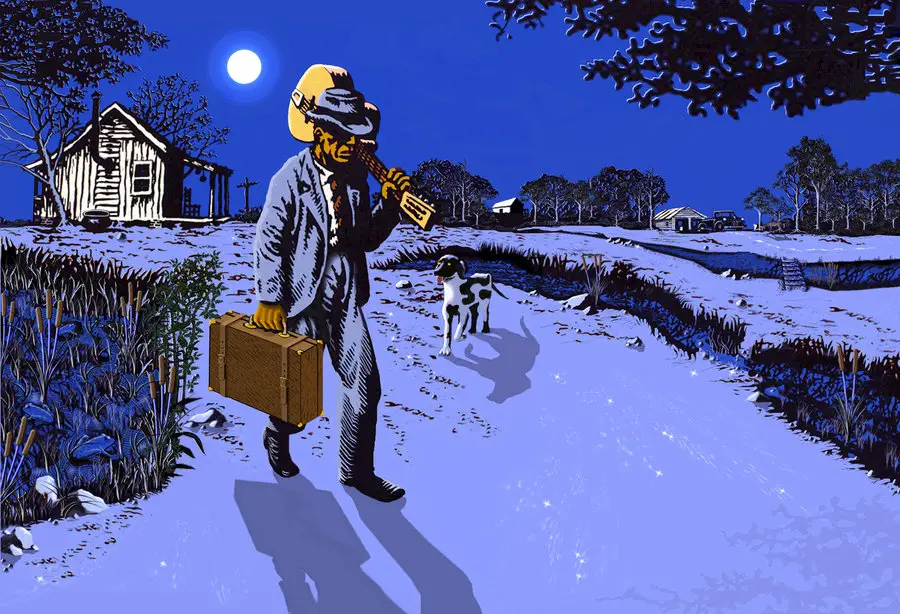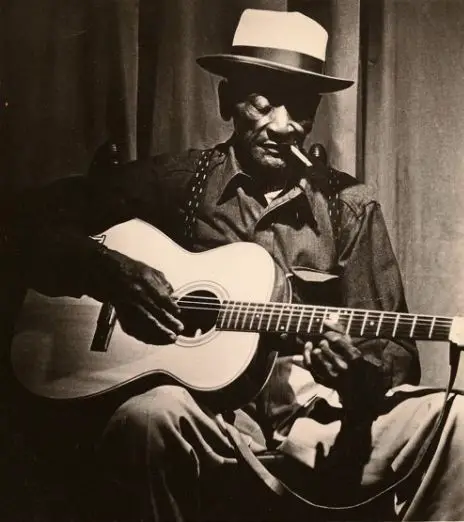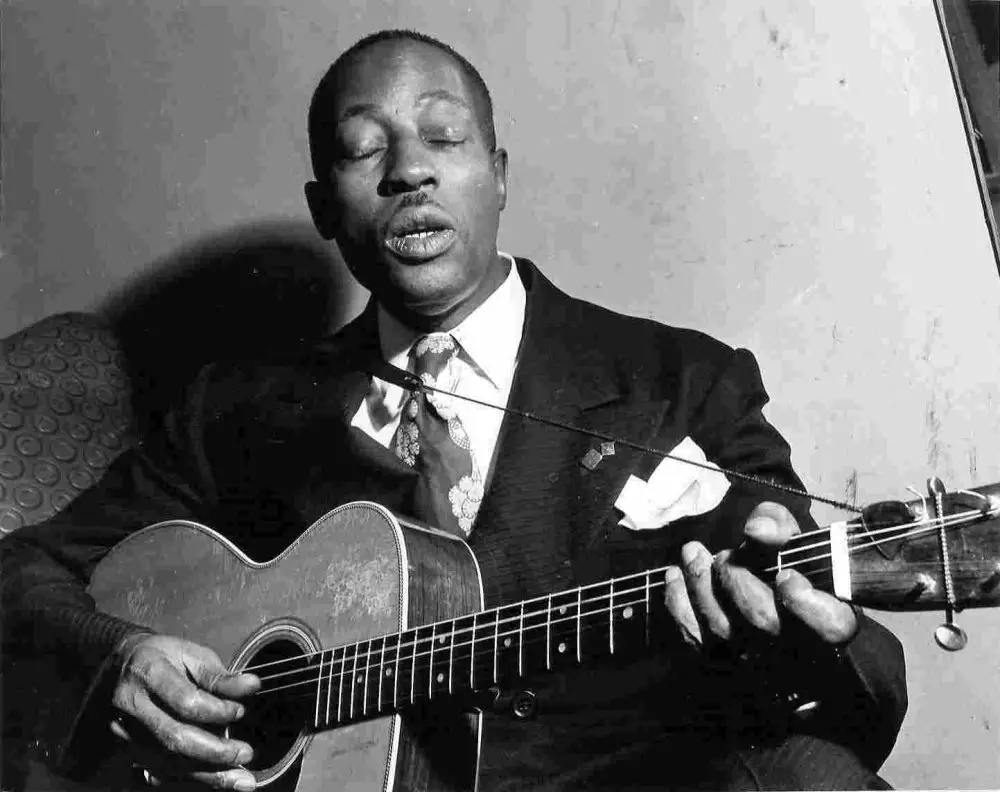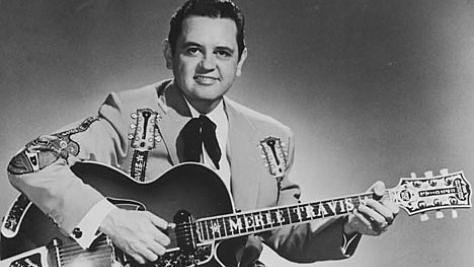Fingerstyle Blues Guitar
 Fingerpicking the blues is probably one of the easiest styles to learn the basics, but one of the most difficult techniques to master, simply because it's not all technique but feeling.
Fingerpicking the blues is probably one of the easiest styles to learn the basics, but one of the most difficult techniques to master, simply because it's not all technique but feeling. Fingerstyle blues guitar has been around for a long time, since the turn of the 20 century and in the beginning it was very basic indeed.
In modern times the style has been honed into an incredibly complex and rich sound, to the extent that all kinds of music from rock to ragtime has been transposed and played by contemporary masters.
Acoustic fingerstyle blues is a wonderful sound and it's easy for the beginner to become a bit overwhelmed. Where do you start?
The best way is to have a very patient teacher, but this tends to be slow (and expensive!). By far the best method is to use great and accurate guitar tabs. The best examples of fingerstyle blues tabs are very good, and once learned, really accelerate learning the guitar.
FINGERSTYLE BLUES GUITAR TABS
Guitar tab looks a bit like music notation, but really has little to do with it. The six guitar strings are represented by horizontal lines, with the bass E string at the bottom.
A number denotes the fret which should be held down for each string, a downward stroke at the side of the number indicates that the thumb should be used and an upward stroke means you should strike with a finger.

It doesn't matter which finger you use, but many early blues players favored just their forefinger, which gave the music a special flavor.
Ragtime guitarists often used two or more fingers, but mostly two, simply because they wanted to play highly syncopated guitar at such a speed that using one finger would be extremely difficult. Artists such as Blind Blake fit into this category.
Beginning Fingerstyle Blues Guitar
You need to be competent at strumming the guitar and changing chords competently, and I always recommend that the beginner starts of with the monotonic bass style of picking.
Before describing this, it's worthwhile stating that for all styles of fingerpicking the guitar, the thumb really is the key to it all. It's incredibly important to study the first steps well so that the new student can build on solid foundations, just as in all facets of education.
The monotonic bass style is so-called because the thumb hits just one or more bass strings in time with the music instead of moving form one string to another. There are a couple of advantages to this way of picking. First of all, done probably it sounds very 'bluesy' and old-style.
Secondly, if we don't focus on the thumb we can be more inventive with our fingers for playing a more complex and interesting melody line on the treble strings.
Big Bill Broonzy, Lightnin' Hopkins and Mance Lipscombe were masters in this way of playing the blues fingerstyle. Listen to Big Bill singing 'Trouble in Mind' to get a feel for this way of picking:
Big Bill Broonzy - Fingerstyle Blues Guitar.mp3
 When playing the monotonic bass pattern, it's essential to learn how to damp or mute the strings to some extent.
When playing the monotonic bass pattern, it's essential to learn how to damp or mute the strings to some extent. When playing a chord such as E, the bass E played open is part of chord's note structure, so it sounds good if you let it ring.
Nevertheless, there are times when we want to choke off the note, or damp it, so that it sounds more like a thud or 'thunk' reminiscent of a drum beat. When playing other chords, it's sometimes essential to damp.
For example, when playing a C chord, the bass E string needs to be fretted on the 3 fret, or it can sound discordant. However, we can play it open i.e. un-fretted, if we choke off the note before it sounds out. So how is it done?
When playing fingerstyle blues songs, the palm of the picking hand is generally held very close to the guitar bridge. If the palm is dropped onto the bass strings just after they are picked, the note is muted before it starts to ring out.
If wwe mute the bass hard enough, then the note hardly sounds at all and we don't need to fret that string. Some players, like Mance Lipscombe for instance, often played in the keys of C and G without fretting his bass strings at all and it worked great!
Listening to the old blues guys above, you'd be right in guessing that there's whole lot more than just a little string damping going on. Take Big Bill Broonzy.
He's damping those bass strings hard, but the music just swings along at a reckless pace and you just can't keep your feet still. Playing blues guitar in this style is the result of several small movements and techniques that combine to give the music some 'zip'.

 Travis fingerstyle guitar is best described in the way that the thumb moves. We discussed how the monotonic bass pattern used just one bass string, often with a palm damping technique.
Travis fingerstyle guitar is best described in the way that the thumb moves. We discussed how the monotonic bass pattern used just one bass string, often with a palm damping technique.

Like Blind Boy Fuller and others, Broonzy could leave the bass pattern altogether and play a single note melody either with his forefinger, thumb or a combination of both.
The trick is to move back to the bass pattern seamlessly so as not to disturb the rhythm. I suspect that he used just one finger, in common with Rev Gary Davis, Doc Watson and others.
While playing the basic melody of a song (see Glory of Love in the Youtube playlist above), his finger would strike a second string or note in between the main melody.
These are called 'grace notes', a term coined by Ernie Hawkins to denote that although they are not part of the melody, they greatly enhance the sound and make it very appealing.
When done properly it's very effective, but takes a lot of practice to get it just right.
Big Bill Broonzy's 'Big Thumb'
Broonzy once explained that you can sit on the back of a horse, on the middle, or on the back but your still moving along at the same speed, and this is how I play guitar.
He meant that you can hit the bass string with your thumb on the beat, before it or after it. Broonzy chose to lag behind the beat a little, which is what made the music swing along.
The big swing bands of the 40s and 50s did the same thing, which was great for dancing.
What Is Travis Picking?
 Travis fingerstyle guitar is best described in the way that the thumb moves. We discussed how the monotonic bass pattern used just one bass string, often with a palm damping technique.
Travis fingerstyle guitar is best described in the way that the thumb moves. We discussed how the monotonic bass pattern used just one bass string, often with a palm damping technique. In Travis fingerpicking, the thumb moves backwards and forwards, or 'alternates' between two or more bass strings. The resulting sound sounds much more complex and gets the feet tapping.
The style was named after Merle Travis, but it was a favorite back in the beginning of commercial blues music after the turn of the 20th century.
This style of picking actually originates in the very early days of fingerstyle blues guitar, just after the ragtime piano was brought right into the spotlight by Scott Joplin.
The characteristic 'bum-chick' sound of the piano bass pattern could be approximated by alternating the bass string thumb strikes on a guitar, and thus ragtime guitar was born.
It has since been honed into an incredibly complex form by modern players like Chet Atkins, Mark Knopfler and Tommy Emmanuel.
Author: Jim Bruce
Date: 2013-12-25
Category: Music

